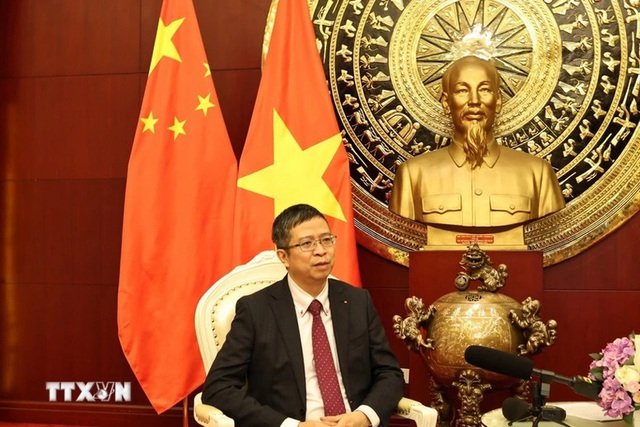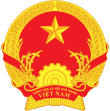Ambassador highlights significance of Xi Jinping's Viet Nam visit
VGP - The state visit to Viet Nam by General Secretary of the Communist Party of China Central Committee and President of China Xi Jinping from April 14-15 holds great significance and symbolic importance for the two countries’ relationship, said Vietnamese Ambassador to China Pham Thanh Binh.

Vietnamese Ambassador to China Pham Thanh Binh
This is Xi's first foreign visit in 2025, and his fourth visit to Viet Nam as China's top leader, and the second within his current term.
The visit demonstrates the high regard that the Chinese Party and State, as well as General Secretary and President Xi Jinping personally, place on strengthening the friendly neighborliness and comprehensive cooperation between Viet Nam and China.
The trip takes place at a pivotal moment for both Parties, both countries, and for their relations. The bilateral relations have maintained a strong and positive momentum, with many notable highlights in cooperation across all fields. Both nations are actively implementing activities to celebrate the 75th founding anniversary of their diplomatic ties and the Viet Nam–China Year of Humanistic Exchanges this year.
Therefore, the visit serves as an opportunity for the top leaders of the two Parties and two countries to further engage in in-depth strategic discussions, assess the bilateral relations, particularly the outcomes achieved in implementing high-level agreements, and chart major directions and key measures to develop the bilateral relationship in a more stable, substantive, and effective manner in the time ahead.
Building on the tradition of friendship and established practices between the two sides, the Party, State, and people of Viet Nam attach great importance to this visit and will extend a special and warm welcome to the Chinese Party General Secretary and President, said the Ambassador.
Within the framework of the trip, Xi will hold talks and meetings with General Secretary of the Communist Party of Viet Nam Central Committee To Lam, President Luong Cuong, Prime Minister Pham Minh Chinh, and National Assembly Chairman Tran Thanh Man.
The two sides are expected to update each other on the situation in each Party and country, engage in in-depth discussions on further strengthening and deepening the bilateral relations, including promoting the tradition of regular high-level exchanges, enhancing political trust, effectively implementing high-level common perceptions and signed agreements, and expanding and improving the effectiveness and quality of cooperation in line with the "six major orientations", aiming to achieve practical outcomes and new milestones.
The diplomat expressed his belief that Xi's visit will leave a historic mark, providing a strong impetus and creating a favorable foundation for the development of the bilateral ties in the new phase. It will continue to outline strategic arrangements and key directions, ensuring that Viet Nam–China relations continue to develop steadily and robustly, and gain breakthrough achievements for the development of both countries.
The two countries will continue to strengthen political trust and mutual understanding, accelerate the implementation of cooperation agreements and projects, add new content, measures, directions, and mechanisms to make the bilateral ties more comprehensive and practical, thus meeting the common aspirations of their people and contributing positively to peace and progress for humanity, the Ambassador said.
Regarding trade ties, the diplomat affirmed that bilateral trade has made significant strides, with Viet Nam maintaining its position for many years as China's largest trading partner within the Association of Southeast Asian Nations (ASEAN), and becoming its fourth-largest globally in 2024.
Based on the common perceptions of high-ranking leaders of the two Parties and nations, Viet Nam and China are accelerating infrastructure connectivity, focusing on railways, highways, and border gate infrastructure.
As bilateral trade continues to expand, the demand for multimodal transport is increasing. Along with road, air, and sea transport, rail freight transport is a suitable option to enhance transport connectivity between the two countries.
In this context, Lao Cai-Ha Noi-Hai Phong, Dong Dang-Ha Noi, and Mong Cai-Ha Long-Hai Phong standard-gauge railway lines are important and strategic transport projects that symbolize the relationship between Viet Nam and China.
Currently, agencies of both sides are actively working together to implement the connectivity of these standard-gauge railways, creating a favorable foundation for trade, economy, tourism, and people-to-people exchanges, bringing significant mutual benefits to both countries.
These railways are expected to help reduce transit time in the border areas, optimize transport costs, and improve the logistics advantages and competitiveness of bilateral intermodal transport. These are favorable factors that will help Viet Nam export more of its key products, such as agricultural and aquatic products, to the Chinese market, as well as bring Chinese products into the Vietnamese market.
Additionally, the railway connectivity will allow Viet Nam to take advantage of rail transport routes connecting China to potential markets such as Central Asia, Eastern Europe, Russia, and the Middle East, contributing to diversifying export markets for Vietnamese goods.
High-quality Chinese products can access the ASEAN market through these rail routes, and the country can take advantage of regional free trade agreements such as the Regional Comprehensive Economic Partnership (RCEP) and the ASEAN-China Free Trade Area (ACFTA).
Currently, there are over 23,000 Vietnamese students in China. Viet Nam is China's largest tourist market among ASEAN Member States each year. In 2024, Viet Nam welcomed approximately 3.7 million Chinese visitors. At present, there are around 400 flights per week between the two countries.
Since the beginning of 2025, designated as the Viet Nam–China Year of Humanistic Exchanges, both sides have closely coordinated in organizing various cultural and people-to-people exchange activities./.

